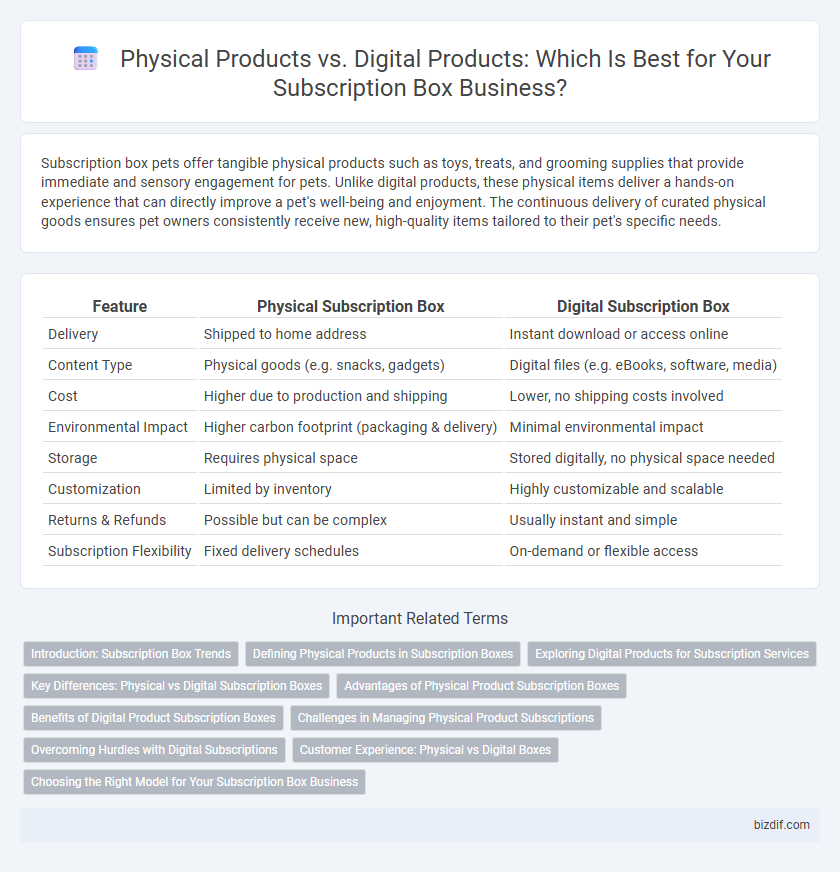Subscription box pets offer tangible physical products such as toys, treats, and grooming supplies that provide immediate and sensory engagement for pets. Unlike digital products, these physical items deliver a hands-on experience that can directly improve a pet's well-being and enjoyment. The continuous delivery of curated physical goods ensures pet owners consistently receive new, high-quality items tailored to their pet's specific needs.
Table of Comparison
| Feature | Physical Subscription Box | Digital Subscription Box |
|---|---|---|
| Delivery | Shipped to home address | Instant download or access online |
| Content Type | Physical goods (e.g. snacks, gadgets) | Digital files (e.g. eBooks, software, media) |
| Cost | Higher due to production and shipping | Lower, no shipping costs involved |
| Environmental Impact | Higher carbon footprint (packaging & delivery) | Minimal environmental impact |
| Storage | Requires physical space | Stored digitally, no physical space needed |
| Customization | Limited by inventory | Highly customizable and scalable |
| Returns & Refunds | Possible but can be complex | Usually instant and simple |
| Subscription Flexibility | Fixed delivery schedules | On-demand or flexible access |
Introduction: Subscription Box Trends
Subscription box trends highlight a growing preference for physical products due to their tangible experience and gift-like appeal, driving higher customer retention and brand loyalty. Digital products, while convenient and instantly accessible, often face challenges in perceived value and engagement compared to curated physical items. Market data shows that subscription boxes offering exclusive physical goods or samples outperform digital-only packages in subscriber growth and satisfaction metrics.
Defining Physical Products in Subscription Boxes
Physical products in subscription boxes refer to tangible items delivered directly to subscribers, including categories like beauty products, snacks, apparel, and fitness gear. These items provide sensory experiences through touch, smell, and sight, enhancing customer engagement and perceived value. The logistics of packaging, shipping, and inventory management play crucial roles in the success of physical product subscription services.
Exploring Digital Products for Subscription Services
Digital products in subscription services offer instant delivery, lower overhead costs, and scalable content updates compared to physical products. Examples include eBooks, software, online courses, and digital art, enhancing customer convenience and personalization. Subscriptions for digital goods can leverage data analytics to tailor recommendations, increase engagement, and reduce environmental impact.
Key Differences: Physical vs Digital Subscription Boxes
Physical subscription boxes deliver tangible items such as beauty products, snacks, or apparel, offering a sensory unboxing experience and immediate utility. Digital subscription boxes provide downloadable or streaming content like eBooks, software, or courses, emphasizing instant access and convenience without shipping costs. Key differences include inventory management, delivery methods, and customer engagement strategies tailored to physical product handling versus digital content distribution.
Advantages of Physical Product Subscription Boxes
Physical product subscription boxes offer tangible experiences that enhance customer satisfaction through sensory engagement and unboxing excitement. These boxes provide lasting value with collectible items and promote brand loyalty by fostering emotional connections. Physical products also facilitate product discovery and trial, encouraging repeat purchases and word-of-mouth marketing.
Benefits of Digital Product Subscription Boxes
Digital product subscription boxes offer instant access to ebooks, software, courses, and exclusive content without shipping delays or storage space concerns. Customers enjoy automatic updates, enhanced customization, and eco-friendly consumption by reducing physical waste. These subscriptions provide cost-effective solutions with flexible usage, enabling easy integration across multiple devices globally.
Challenges in Managing Physical Product Subscriptions
Managing physical product subscriptions involves complex logistics such as inventory control, shipping coordination, and handling returns or damages, which often lead to increased operational costs. Ensuring timely delivery and maintaining product quality across diverse locations pose significant challenges that directly impact customer satisfaction and retention. Warehousing, packaging, and dealing with supply chain disruptions further complicate the scalability of physical subscription services compared to digital products.
Overcoming Hurdles with Digital Subscriptions
Digital subscription products eliminate logistical challenges associated with physical items, such as shipping delays, inventory management, and return processing. Platforms like Audible and Netflix demonstrate scalable content delivery without physical constraints, improving customer retention through instant accessibility and continuous updates. Embracing digital subscriptions allows businesses to overcome traditional barriers, reduce overhead costs, and enhance user engagement with personalized, on-demand experiences.
Customer Experience: Physical vs Digital Boxes
Physical subscription boxes offer a tactile unboxing experience that enhances customer engagement through tangible items, sensory appeal, and personalized packaging, fostering stronger emotional connections. Digital subscription boxes deliver instant access to curated content or software, emphasizing convenience and continuous updates, which cater to users seeking flexibility and immediacy. The choice between physical and digital boxes significantly impacts customer satisfaction, retention, and perceived value based on preferences for sensory interaction versus on-demand access.
Choosing the Right Model for Your Subscription Box Business
Physical products offer tangible experiences and higher perceived value, ideal for subscription boxes like beauty kits, snacks, or fitness gear, attracting consumers who appreciate hands-on engagement. Digital products provide instant delivery and lower delivery costs, appealing to markets such as e-learning, software, or digital art subscriptions, ensuring scalability and minimal inventory concerns. Selecting the right model depends on target audience preferences, cost structure, and long-term business goals for sustainable growth.
Physical products vs digital products Infographic

 bizdif.com
bizdif.com